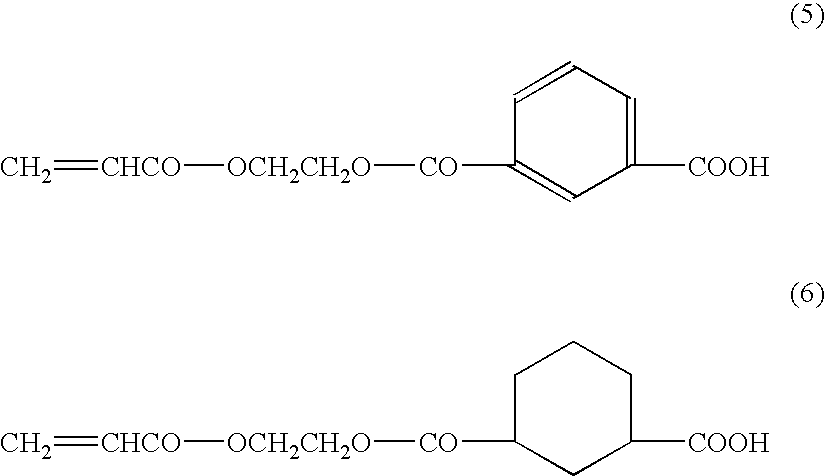Process for coating with radiation-curable resin composition and laminates
a radiation-curable resin and composition technology, applied in the field of coating polyolefin or metal substrates, can solve the problems of insufficient adhesion to nonpolar plastic materials such as polyolefin, metal and glass, and limited use of conventional radiation-curable resin compositions, so as to improve improve the flexibility of the coating. , the effect of improving the adhesion to polyolefin
- Summary
- Abstract
- Description
- Claims
- Application Information
AI Technical Summary
Benefits of technology
Problems solved by technology
Method used
Image
Examples
example 10
[0132] A four-neck flask equipped with a thermometer, stirrer, water-cooled condenser and air inlet was charged with 50 parts (0.075 mole) of a trimer of isophorone diisocyanate, 5.5 parts of (0.037 mole) of dimethylol butanoic acid and 50 parts of ethyl acetate. The mixture was heated to 80.degree. C. and addition reaction was conducted for 2 hours. Then, after introducing air into the reaction solution, 44.5 parts (0.15 mole) of pentaerythritol triacrylate, 0.05 part of methyl ethyl hydroquinone and 0.01 part of dibutyltin dilaurate was added. Reaction was conducted for 5 hours at a constant temperature and finished when the remnant isocyanate group became 0.3% to obtain urethane (meth)acrylic resin containing a carboxyl group [A-4].
[0133] 3 parts of 1-hydroxy-cyclohexyl-phenyl-ketone (Irgacure 184, available from Ciba Specialty Chemicals Co., Ltd.) as a photoinitiator and 182 parts of ethyl acetate were added to 100 parts of the urethane (meth)acrylic resin containing a carboxyl ...
example 11
[0134] Urethane (meth)acrylic resin containing a carboxyl group [A-5] was obtained in the same manner as in Example 10 except that 37.4 parts (0.17 mole) of isophorone diisocyanate, 12.5 parts of (0.085 mole) of dimethylol butanoic acid and 50.1 parts (0.17 mole) of pentaerythritol triacrylate were used instead of 50 parts (0.075 mole) of a trimer of isophorone diisocyanate, 5.5 parts of (0.037 mole) of dimethylol butanoic acid and 44.5 parts (0.15 mole) of pentaerythritol triacrylate of Example 10. Then, an ultraviolet curable resin composition was obtained and evaluated in the same manner as in Example 10. The evaluation results are shown in Table 3.
example 12
[0135] Urethane (meth)acrylic resin containing a carboxyl group [A-6] was obtained in the same manner as in Example 10 except that 50.1 parts (0.075 mole) of a trimer of isophorone diisocyanate, 5.0 parts (0.037 mole) of dimethylol propionic acid and 44.9 parts (0.15 mole) of pentaerythritol triacrylate were used instead of 50 parts (0.075 mole) of a trimer of isophorone diisocyanate, 5.5 parts of (0.037 mole) of dimethylol butanoic acid and 44.5 parts (0.15 mole) of pentaerythritol triacrylate of Example 10. Then, an ultraviolet curable resin composition was obtained and evaluated in the same manner as in Example 10. The evaluation results are shown in Table 3.
PUM
| Property | Measurement | Unit |
|---|---|---|
| Angle | aaaaa | aaaaa |
| Fraction | aaaaa | aaaaa |
| Fraction | aaaaa | aaaaa |
Abstract
Description
Claims
Application Information
 Login to View More
Login to View More - R&D
- Intellectual Property
- Life Sciences
- Materials
- Tech Scout
- Unparalleled Data Quality
- Higher Quality Content
- 60% Fewer Hallucinations
Browse by: Latest US Patents, China's latest patents, Technical Efficacy Thesaurus, Application Domain, Technology Topic, Popular Technical Reports.
© 2025 PatSnap. All rights reserved.Legal|Privacy policy|Modern Slavery Act Transparency Statement|Sitemap|About US| Contact US: help@patsnap.com

